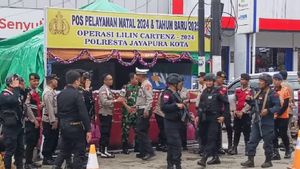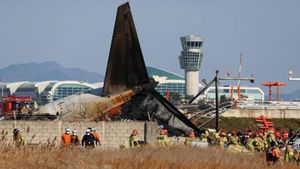JAKARTA - Mount Semeru, located in Lumajang, East Java, experienced an eruption and spewed hot clouds and incandescent lava. More than hundreds of residents living around the slopes and foothills of Mount Semeru had to flee from the affected areas.
Based on a report from the Geology Center for Volcanology and Geological Mitigation (PVMBG) at the Semeru Volcano Observation Post, Mount Semeru's volcanic activity has begun to decline and its status is at level II (Alert). Even so, Mount Semeru still emitted hot clouds as far as 2.5 km and two harmonic tremors.
Visually Mount Semeru is covered with fog. The public is advised not to carry out activities within a one kilometer radius around the hot cloud launch path.
This is because the hot clouds and volcanic ash that Mount Semeru spewed out contain dangerous substances, hydrogen sulfide (H2S), sulfur dioxide (SO2), and nitrogen dioxide. Dust material can damage the human respiratory system, if inhaled.
Hazardous Substances in Volcanic AshBPBD Lumajang Regency and other related agencies have prepared evacuation sites for residents of the eruption of Mount Semeru in Lumajang Regency, East Java at several points as well as assisting aged kitchen services, including the provision of clean water. More: https://t.co/Kv6o1jL8HM pic.twitter.com/8TrOJCOLTz
- BNPB Indonesia (@BNPB_Indonesia) December 2, 2020
When an eruption occurs, the volcano will spew volcanic ash which consists of fine particles of incandescent rock. These particles are capable of irritating the lungs, eyes, writings and airways.
According to data from the American Lung Association, exposure to volcanic ash can harm the health of both humans and animals. Not only that, volcanic ash is also dangerous for aviation activities because it can damage aircraft engines.
As reported on the Halodoc page, it is stated that inhaling volcanic ash can damage human health because the dangerous aerosols and poisonous gases that form ash can irritate the lungs, eyes, and even skin.
Respiratory disorders or acute respiratory infections (ISPA) are the symptoms most often felt by people affected by volcanic ash rain. Symptoms include runny nose, sore throat / cough, wheezing / shortness of breath, and possibly bronchitus.
The fine particles of volcanic ash can also irritate the eyes. Marked from the eye becoming itchy and red, blisters or fine scratches on the cornea to inflammation in the eyeball area or conjunctivitis.
The volcanic ash that is scattered in the air from the impact of a volcanic eruption can also cause skin irritation. This is because volcanic dust particles have irritant and corrosive properties.
This volcanic dust will be even more dangerous for people with sensitive skin. Symptoms begin with reddened skin and itching.
As much as possible to minimize health problems from exposure to volcanic ash, people and refugees are asked to reduce outdoor activities, wear protective glasses that cover the eye, nose and mouth areas, and wear cloth masks.
Disaster Mitigation that needs to be preparedMount Ili Lewotolok erupted on Wednesday, December 2, 2020, at 09:42 WITA. The eruption was recorded on a seismograph with a maximum amplitude of 28 mm and a duration of 22 seconds. https://t.co/e4Eks50nAI via @id_magma
- MAGMA Indonesia (@id_magma) December 2, 2020
Keep in mind, Indonesia is at the junction of the three earth's technological plates. This also causes Indonesia to have many volcanoes or ring of fire.
Understanding these conditions, it is better if the community understands disaster mitigation. In order to minimize casualties and be prepared for disasters.
Quoting recommendations from BNPB, people living in disaster areas need to prepare a number of needs to be aware of emergency conditions. One of them is by preparing a Disaster Preparedness Bag.
Disaster preparedness bags generally contain basic and essential items that must be present when a disaster or emergency occurs according to the needs of each family member. Including food and beverage reserves, if assistance has not arrived.
Here are some things to keep in mind when putting together a disaster preparedness bag:
Important documents such as birth certificates, diplomas, vehicle certificates, family cards, and others. Clothing, including blankets, towels, raincoats and toiletries. Light and durable foods such as instant noodles, shredded, chocolate, biscuits, and others. Drinking water that at least can support needs. Private or public medicine. Lighting aids such as flashlights, candles, matches, and so on. Prepare cash in bags for supplies during evacuation. Whistle as a aid tool if at any time stuck. Mask as a respiratory protection device. Radio or cell phone to monitor more information about natural disasters. Do not miss, the charger cable and power bank.The English, Chinese, Japanese, Arabic, and French versions are automatically generated by the AI. So there may still be inaccuracies in translating, please always see Indonesian as our main language. (system supported by DigitalSiber.id)










